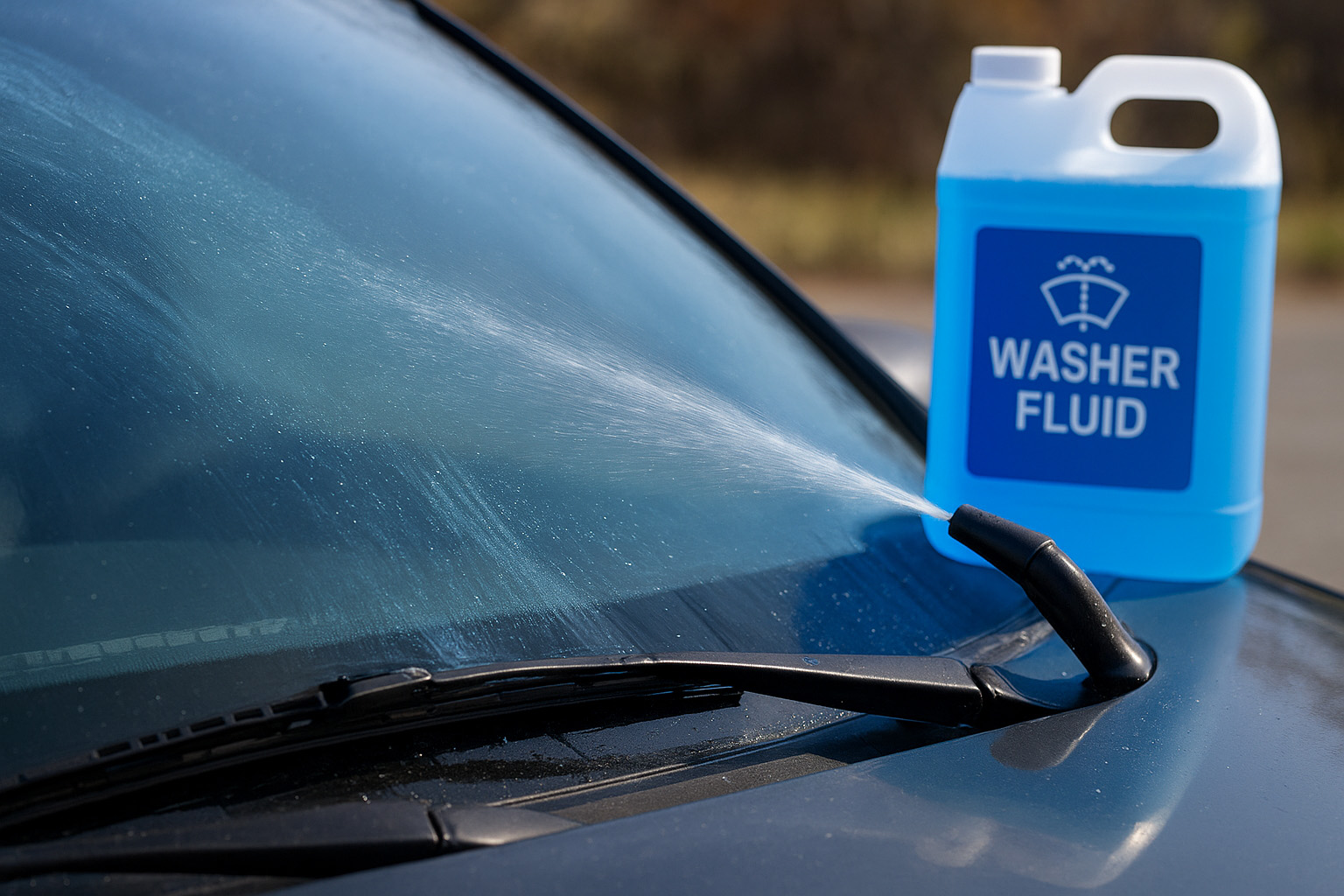When it comes to vehicle maintenance, windshield washer fluid might seem like a small detail, but it plays a big role in your safety on the road. A clean windshield ensures clear visibility, helping you react faster to potential hazards. Knowing which washer fluid to use (and how to maintain it) can make a noticeable difference, especially in extreme weather conditions.
Below, we’ll explain what windshield washer fluid is, how to tell when it’s low, the various types available, and why choosing the right one matters.
What Is Windshield Washer Fluid and Why Is It Important?
Windshield washer fluid is a specially formulated liquid designed to clean your windshield while you drive. It helps remove dirt, bugs, road salt, mud, and other debris that can obstruct your vision. Most washer fluids also contain detergents and anti-freeze agents that prevent streaks and keep the fluid from freezing inside the reservoir or on your windshield.
Unlike plain water, washer fluid is made to handle the specific challenges of driving conditions, whether it’s bug splatter in the summer or icy buildup in the winter.
How to Know When You’re Low on Washer Fluid
Many modern vehicles have a dashboard light that indicates when your washer fluid is low. If your car doesn’t, you’ll typically notice reduced spray pressure or no spray at all when you try to clean your windshield.
To check manually:
- Open your vehicle’s hood.
- Look for a reservoir labeled with a windshield/water icon.
- If you can’t see fluid near the top, it’s time to refill.
How to Refill Windshield Washer Fluid
Refilling washer fluid is quick and easy:
- Purchase the appropriate washer fluid for your region or season.
- Open the cap on the windshield washer reservoir.
- Pour the fluid in slowly until it reaches near the top.
- Replace the cap securely.
Avoid using plain water, especially in colder climates, as it can freeze in the lines or create streaks on your windshield.
The Different Types of Windshield Washer Fluid
Not all washer fluids are created equal. The type you use should match your local weather conditions and driving habits. Here are the main varieties:
1. All-Season Washer Fluid
- What it is: A balanced blend suitable for both warm and cold weather.
- Best for: Drivers who want year-round convenience and live in areas with moderate weather.
- Why it matters: It can handle light frost and bugs while offering solid cleaning power without switching fluids between seasons.
2. De-Icing or Winter Washer Fluid
- What it is: Contains antifreeze agents like methanol or ethylene glycol to prevent freezing, even in subzero temperatures.
- Best for: Cold climates with snow, ice, or slush.
- Why it matters: It melts ice and frost on contact, preventing frozen nozzles and ensuring reliable cleaning in winter conditions.
3. Bug Remover or Summer Washer Fluid
- What it is: A stronger detergent-based formula designed to break down bug residue, tree sap, and road grime.
- Best for: Hot climates and summertime driving.
- Why it matters: Keeps your windshield clear of sticky residue that can smear when wiped with standard fluids.
4. Water-Repellent Washer Fluid
- What it is: Contains hydrophobic (water-repelling) additives that create a thin protective coating on the windshield.
- Best for: Rainy regions or anyone who frequently drives in wet conditions.
- Why it matters: It improves visibility during heavy rain by causing water to bead and roll off faster.
5. Concentrated Washer Fluid
- What it is: A fluid you mix with water before use, allowing for customization based on temperature or cleaning needs.
- Best for: Drivers who prefer control over their mixture or want a cost-effective option.
- Why it matters: You can adjust the ratio for winter or summer conditions as needed, but it requires careful mixing to avoid dilution issues.
How to Tell the Difference Between Fluid Types
Washer fluid bottles are typically color-coded and clearly labeled:
- Blue: All-season or standard fluid
- Orange or Yellow: Bug remover or summer blend
- Purple or Green: Water-repellent or premium formulations
- Light Blue or Pink: Winter/de-icing fluid
Always read the label before refilling, using a summer blend in freezing weather can cause the fluid to solidify in your lines or nozzles.
Why It Matters Which Type You Use
Using the wrong type of washer fluid can lead to:
- Frozen lines and nozzles (if summer fluid is used in winter)
- Smearing and streaking that impair visibility
- Reduced effectiveness at removing debris or bugs
- Increased wear on wiper blades due to improper lubrication
Choosing the right washer fluid helps you maintain clear vision, protect your windshield wipers, and prevent damage to the washer system.
Protecting Your Windshield
Even with the right washer fluid, debris and road hazards can still lead to chips or cracks over time. A damaged windshield can weaken your vehicle’s structural integrity and obstruct your field of vision.
If you notice any chips or cracks, don’t wait to get them checked. At AutoGlassEstimator.com, you can use our free quote tool to quickly find trusted shops near you for windshield repair or replacement.
Getting multiple quotes helps you compare prices, services, and reviews—all in minutes. Keeping your windshield in top condition ensures your washer fluid can do its job effectively and that you stay safe on the road.
In Summary:
Windshield washer fluid may seem minor, but it’s a crucial part of vehicle safety. From all-season blends to specialized winter or bug-removing formulas, choosing the right type for your driving environment helps maintain visibility and extend your windshield’s life.
If your windshield ever needs more than a quick clean, head to AutoGlassEstimator.com to find reliable professionals and get a free replacement quote today.

